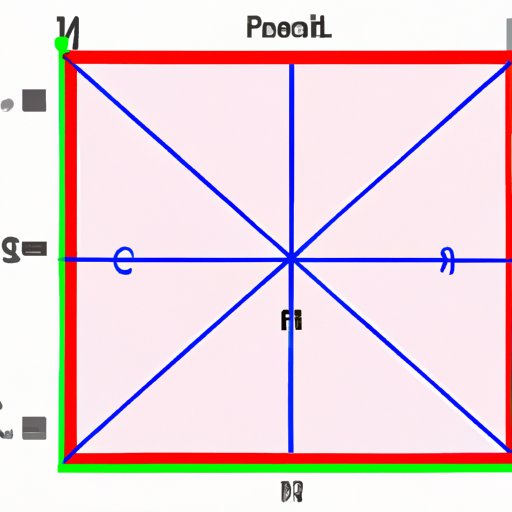
I. Introduction
Knowing how to find the perimeter of a square is an essential skill in math and everyday life. Perimeter refers to the total distance around the outside of a shape, and understanding how to calculate it can be helpful in many real-world applications. Whether you are a student, a professional, or someone who simply enjoys learning, this article will provide a step-by-step guide on how to find the perimeter of a square.
II. Step-by-Step Guide to Finding the Perimeter of a Square
The perimeter of a square is the total distance around its four sides. To find the perimeter of a square, simply add up the length of all its sides.
For example, if you have a square with sides of length 5 cm, the perimeter would be:
Perimeter = 5 + 5 + 5 + 5 = 20 cm
Therefore, the perimeter of the square is 20 cm.
III. The Formula and Methods for Calculating the Perimeter of a Square
The formula for calculating the perimeter of a square is:
Perimeter = 4 x length of one side
There are multiple ways of calculating the perimeter of a square. One method is to simply add up the length of all its sides, as shown in the previous section. Another method is to multiply the length of one side by the number four, as per the formula.
Both methods are accurate and can be used interchangeably. However, the formula is particularly useful when dealing with larger or more complex squares, as it saves time and reduces the likelihood of errors.
IV. Examples and Exercises for Finding the Perimeter of a Square
Let’s take a look at a few examples of how to find the perimeter of a square using both methods:
Example 1:
Length of each side = 8 cm
Perimeter = 8 + 8 + 8 + 8 = 32 cm
Perimeter = 4 x 8 = 32 cm
Example 2:
Length of each side = 3.5 cm
Perimeter = 3.5 + 3.5 + 3.5 + 3.5 = 14 cm
Perimeter = 4 x 3.5 = 14 cm
Now, it’s your turn. Try these exercises to practice finding the perimeter of a square:
Exercise 1:
Length of each side = 10 cm
Perimeter = ?
Exercise 2:
Length of each side = 6.2 cm
Perimeter = ?
V. Visualizing the Perimeter of a Square: Tips and Tricks
Visualizing the perimeter of a square can be challenging at first, but there are a few tips and tricks that can make it easier. One way is to break the square into smaller shapes and add up their perimeters. For example, you can break a square into two rectangles, and then add up the lengths of all four sides:
Another way to visualize the perimeter of a square is to use a grid or graph paper. Draw the square on the paper and count the number of squares along its edges. Multiply that number by the length of one square to find the perimeter.
VI. The Importance of Knowing How to Find the Perimeter of a Square
Knowing how to find the perimeter of a square is important for many real-world applications. For example, it can help with calculating the perimeter of a space when installing new flooring or fencing, or when measuring the area of a room for painting or carpeting. It is also useful in the fields of architecture, engineering, and construction.
Furthermore, understanding the concept of perimeter can help with more complex geometry problems, such as finding the perimeter of irregular polygons or calculating the distance traveled by a vehicle on a circular track.
VII. Common Mistakes to Avoid When Calculating the Perimeter of a Square
One common mistake when calculating the perimeter of a square is to forget to add up all four sides. Another mistake is to confuse the perimeter with the area of a square, which refers to the space inside the shape.
To avoid these mistakes, it is important to double-check your work and to only use the formula or method that you are most comfortable with.
VIII. Real-World Applications of Finding the Perimeter of a Square
Here are some examples of how finding the perimeter of a square is used in real-world applications:
– Installing new flooring or fencing: calculating the perimeter of a space to determine how much material is needed
– Measuring the area of a room for painting or carpeting: determining the length of baseboards needed or how much paint or carpet is required
– Architecture, engineering, and construction: calculating the perimeter of structures and spaces to ensure stability and safety
– Calculating the distance traveled by a vehicle on a circular track: breaking the circular track into smaller squares and adding up their perimeters
IX. Conclusion
In conclusion, finding the perimeter of a square is a fundamental concept in math and everyday life. Whether you are a student, a professional, or someone who simply enjoys learning, it is important to understand how to calculate the perimeter of a square.
This article provided a step-by-step guide on how to find the perimeter of a square, including its formula, different methods of calculation, real-world applications, and more. We also discussed tips and tricks for visualizing the concept, as well as common mistakes to avoid.
We hope this article has been informative and helpful in improving your understanding of finding the perimeter of a square.




